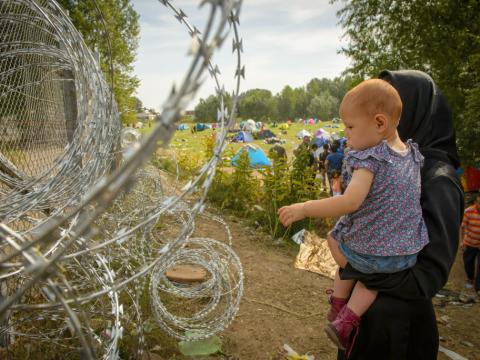Europe's refugee crisis: Confusion reigns, families struggle

As the leaders of the European Union come together this week for an emergency meeting to address the crisis that has seen frontline states overwhelmed by refugees and migrants, one of the biggest questions is whether the talks will bring countries together in a unified, holistic approach.
Can the EU member nations agree, not simply on sharing the burden of relocating refugees, but addressing the need to meet humanitarian needs in countries of first refuge and stopping the conflicts which are driving families from their homes? Without this the patchwork of changing policies will continue to breed confusion, despair and growing tension.
...the patchwork of changing policies will continue to breed confusion, despair and growing tension.
In the past week, World Vision’s work in Serbia has moved from government organised camps, to the infamous Hungarian border at Horgos, and finally to the Croatian border where our work will continue. As the media have moved on and the reality on the ground continues to diverge from official policies and announcements, our team increasingly relies on a network of contacts to know where refugees are gathering or on the move, and what their most pressing needs are likely to be.
While we hand water, food and nappies to anxious mothers, they ask our team for the one thing no one has been able to provide: reliable information. “Is the border really open?” “How far do we walk?” “How long?” Questions they’ve no doubt repeated along the way.
Four days after the Hungarian border at Horgos closed, most of the thousands of people present days before had left. With the Hungarian border sealed, rumours quickly travelled that Croatia offered a new hope for their journey. For families with young children, the decision to set out again on the basis of second-hand information, in this rapidly changing environment, is not an easy one.
In the small group of tents that remained, our team met Kenaz, a Syrian refugee travelling with her three children who are nine, three and one year old. Finding the border closed after 10 days of travel had temporarily stopped this family in their tracks. The despair and frustration of this situation showed clearly in Kenaz’ silent tears, and the concerned expression of her eldest daughter. When our team returned that afternoon, the family’s tent was gone. We can only assume Kenaz has made the next in a series of impossibly difficult decisions and started the journey to the Croatian border.
RELATED: PHOTO GALLERY OF SYRIAN REFUGEES IN SERBIA
For those fleeing violence and conflict in Syria, Iraq, Afghanistan, Eritrea and Somalia, the decision to set out for Europe is not taken lightly. The risk of death at sea is real, the journey is hazardous and a new life in safety and peace is far from guaranteed. But as long as the alternative exposes their children to violence and terror, denies them the right to food and an education, parents will continue to embark on this journey in the hope of finding refuge for their families.
The daily changes in policy and rhetoric show that this crisis is beyond the capacity of any one country to address.
The daily changes in policy and rhetoric show that this crisis is beyond the capacity of any one country to address. The outpouring of compassion that followed the heart-breaking image of little Aylan’s lifeless body is being undermined by voices urging a return to indifference and fear. The world will be watching closely this week to see whether solidarity can overcome the growing divisions between member states, and ultimately to see whether the European Union can harness its power to uphold compassion and humanity in a time of crisis.
Conny Lenneberg is the Regional Leader for World Vision's Middle East / Eastern Europe Regional Office.
Please contact Joy Toose, Emergency Communications for more information.